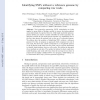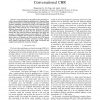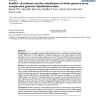2345 search results - page 27 / 469 » Comparing sequence scaffolds |
TNN
1998
13 years 7 months ago
1998
—Adaptive resonance theory (ART) describes a family of self-organizing neural networks, capable of clustering arbitrary sequences of input patterns into stable recognition codes....
SPIRE
2010
Springer
13 years 5 months ago
2010
Springer
Next generation sequencing (NGS) technologies are being applied to many fields of biology, notably to survey the polymorphism across individuals of a species. However, while single...
IRI
2005
IEEE
14 years 1 months ago
2005
IEEE
Abstract— Conversational Case-Based-Reasoning (CCBR) provides a mixed-initiative dialog for guiding users to construct their problem description incrementally through a question-...
DOLAP
2000
ACM
13 years 12 months ago
2000
ACM
A multidimensional database can be seen as a collection of multidimensional cubes, from which information is usually extracted by aggregation; aggregated data can be calculated ei...
BMCBI
2004
13 years 7 months ago
2004
Background: Array comparative genomic hybridization (CGH) is a technique which detects copy number differences in DNA segments. Complete sequencing of the human genome and the dev...



